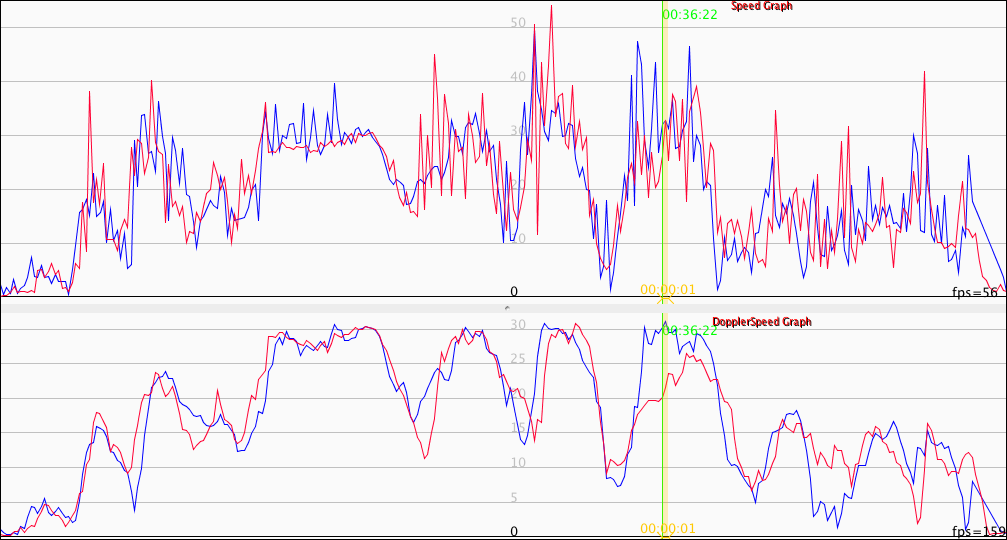In my recent post about comparing 5 GPS units, I had described how one of the two GPS units I used had given substantially worse results than the other one. One of the great names in speedsurfing, Andrew Daff (aka Sailquick), pointed out that this could be due to differences in settings - and he was right. I discovered that my "bad" GT-31 still was set to "low power" mode, while the other unit was in "normal" power mode. It appears that the "low power" mode restricts the GT-31 to tracking at most 6 satellites; in normal power mode, the unit can track 8 or more satellites, which gives much better accuracy. I took both GT-31s I had for a drive to see the effect - here are the tracks from "low power" mode:
 |
| Low power mode tracks from two GT-31s |
 |
| Normal power mode tracks from two GT-31s |
 |
| Low power mode circles |
 |
| Normal power mode circles |
Here are the speed and doppler speed graphs for the low power mode:
 |
| Speed graphs for low power mode |
For comparison, here are the speed graphs in normal power mode:
 |
| Speed graphs for normal power mode |
Fortunately, the "normal" power mode is the default setting for the GT-31 (I think). So why did I ever switch my GT-31 to "low power"? I did it when I tried to set a personal best for distance within 24 hours. Somewhere, I picked up a suggestion to switch to low power mode to make sure that the battery would last long enough. Neither the suggester nor I had seen Redsurfbus' comment that low power mode creates spikes...
I did not even sail 24 hours that day. I got too tired after sailing about 12 hours in chop, sailing only 270 km. Apparently, I was still too tired the next day to remember to set the power mode back to normal. This affected my jibe analysis using GPS data for the next two years...
What do we learn? Well, if you have a GT-31, go to "Settings", scroll down to "Power mode", and make sure it is set on "Normal". The other take-home message I took from this is that the number of satellites tracked is a very useful bit of information to have - it is tightly linked to speed accuracy. Although I believe that other factors also come into play when SDoP and HDoP are calculated, the number of satellites could be a good-enough stand-in for recreational (i.e. non-record) windsurfing. With newer GPS chips typically tracking more satellites than the old Sirf3 chip, if should be possible to set the minimum number of satellites higher that the currently suggested cutoff of 5 - at least to 7 or perhaps 8. Why does this matter? Because only very few GPS units can record accuracy values (SDoP and HDoP) directly, but many support the NMEA format that does support satellite information, or similar formats.
I really hope that I'll be done with this geeky stuff for now, and that the promised wind will show up tomorrow and this weekend so that I can spend some time on the water!